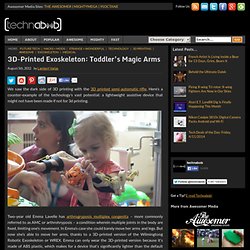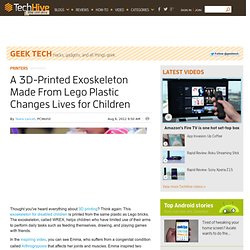

3D-Printed Exoskeleton: Toddler’s Magic Arms. August 5th, 2012 by Lambert Varias We saw the dark side of 3D printing with the 3D printed semi-automatic rifle.

Here’s a counter-example of the technology’s vast potential: a lightweight assistive device that might not have been made if not for 3d printing. Two-year old Emma Lavelle has arthrogryposis multiplex congenita – more commonly referred to as AMC or arthrohryposis – a condition wherein multiple joints in the body are fixed, limiting one’s movement. In Emma’s case she could barely move her arms and legs. But now she’s able to move her arms, thanks to a 3D-printed version of the Wilmingtong Robotic Exoskeleton or WREX. A 3D-Printed Exoskeleton Made From Lego Plastic Changes Lives for Children.
Thought you've heard everything about 3D printing?

Think again: This exoskeleton for disabled children is printed from the same plastic as Lego bricks. The exoskeleton, called WREX, helps children who have limited use of their arms to perform daily tasks such as feeding themselves, drawing, and playing games with friends. In the inspiring video, you can see Emma, who suffers from a congenital condition called Arthrogryposis that affects her joints and muscles. Nemours. The moment Megan Lavelle saw the device, she knew it would change her daughter’s life.

Lavelle is an energetic, unstoppable mom whose youngest daughter, Emma, was born with arthrogryposis multiplex congenita (AMC). At a Philadelphia conference for AMC families, Lavelle learned about the Wilmington Robotic Exoskeleton (WREX), an assistive device made of hinged metal bars and resistance bands.